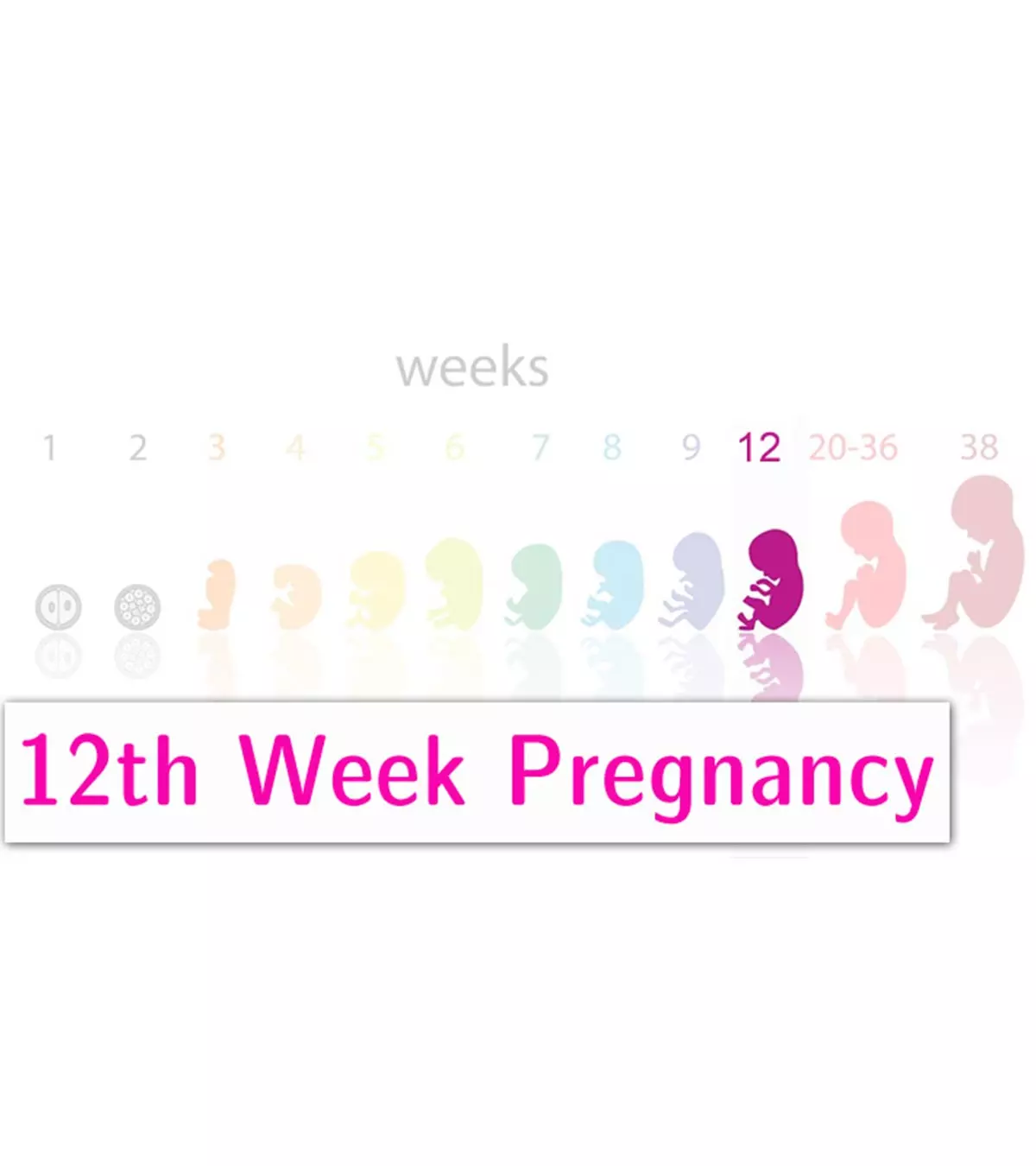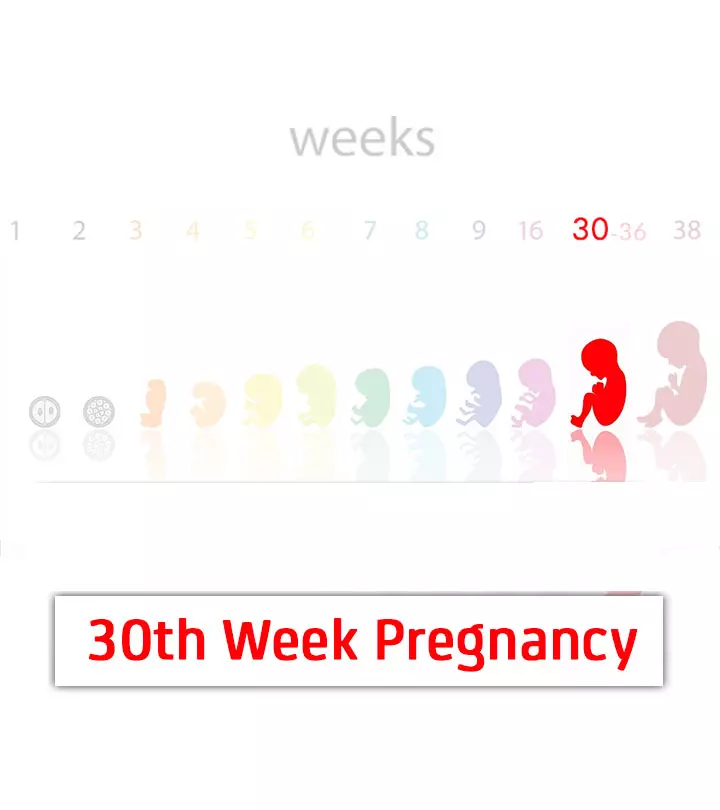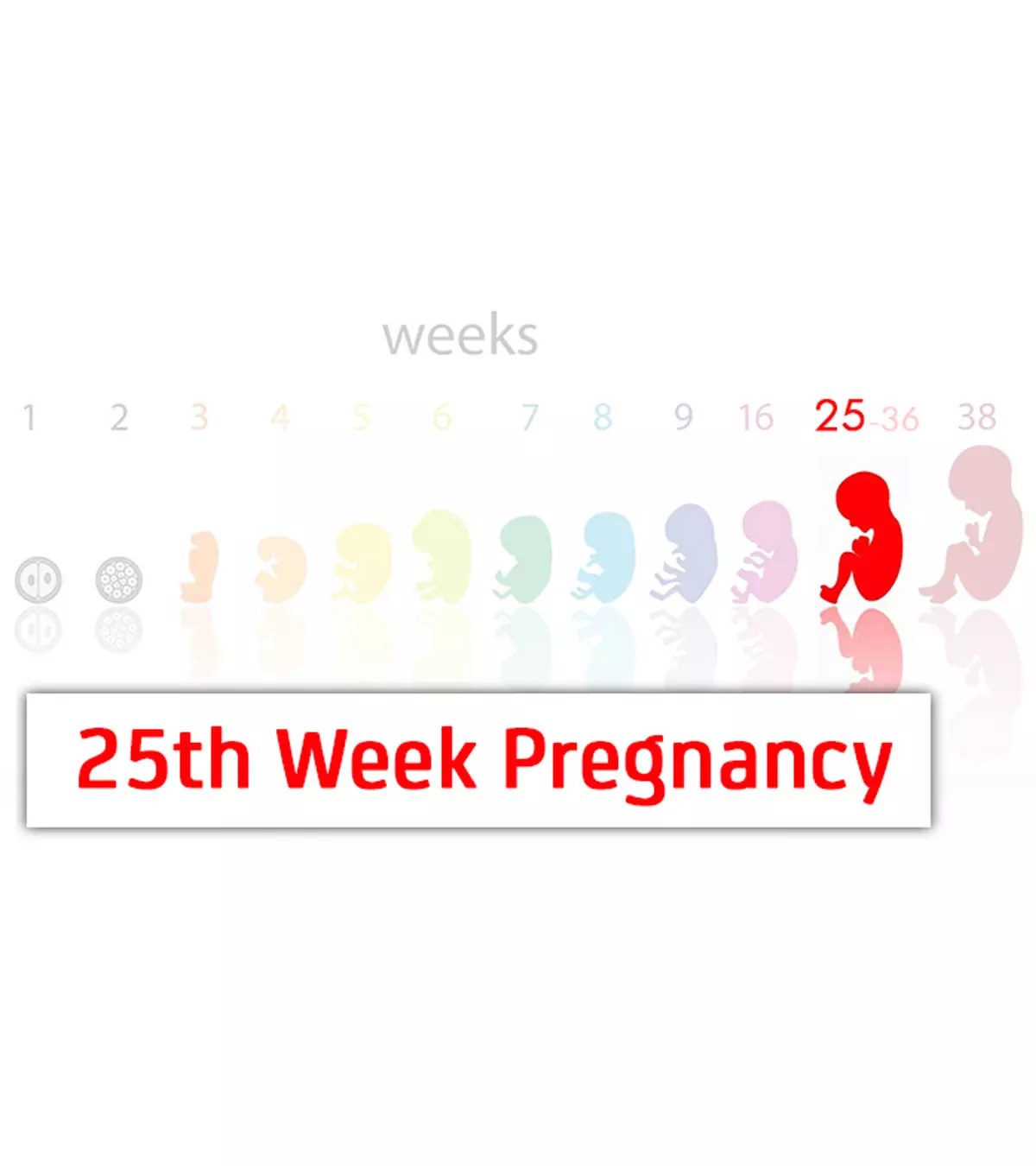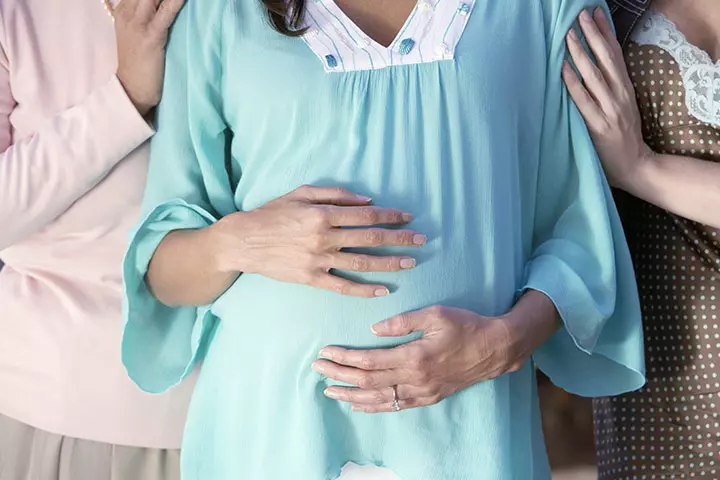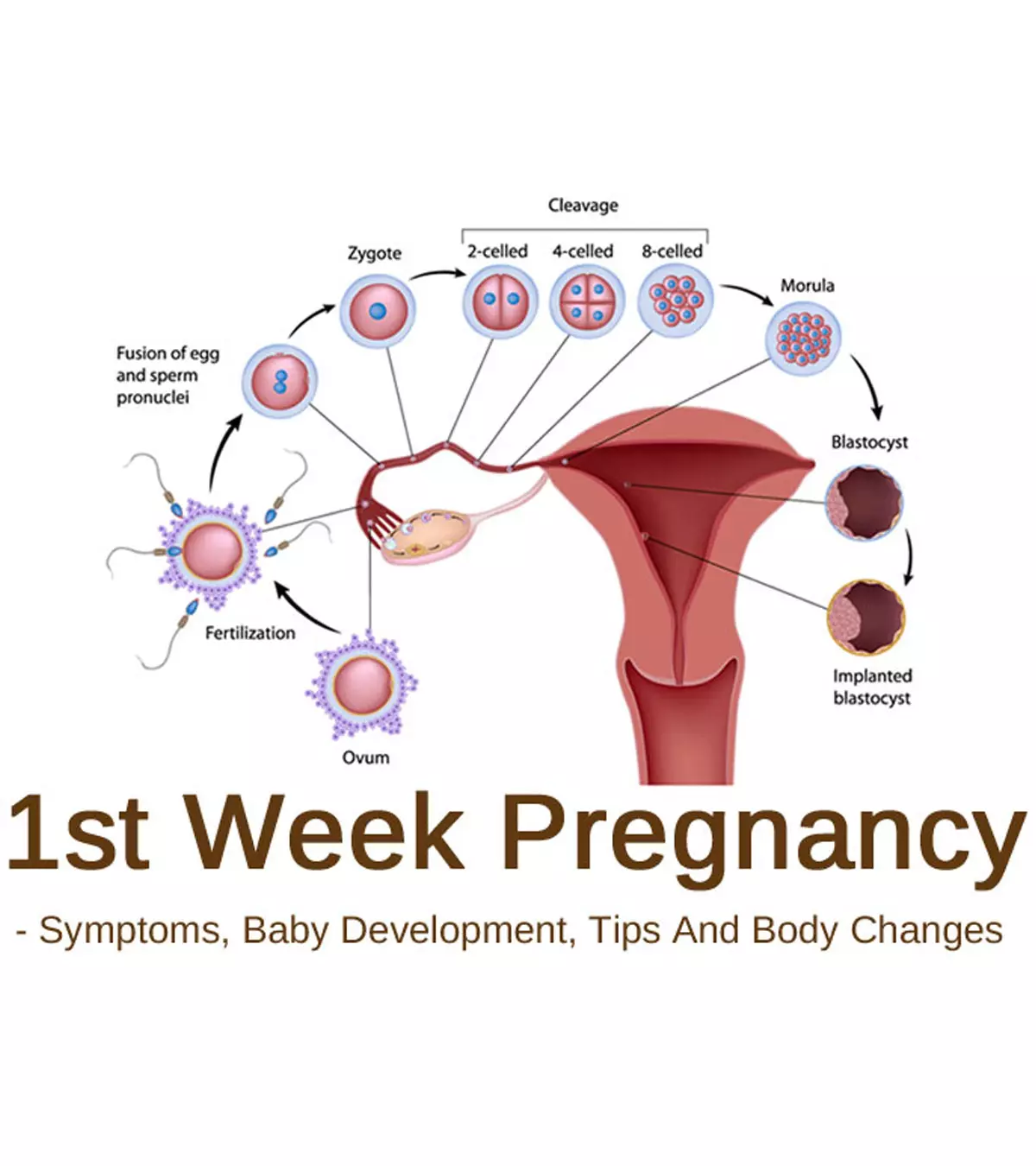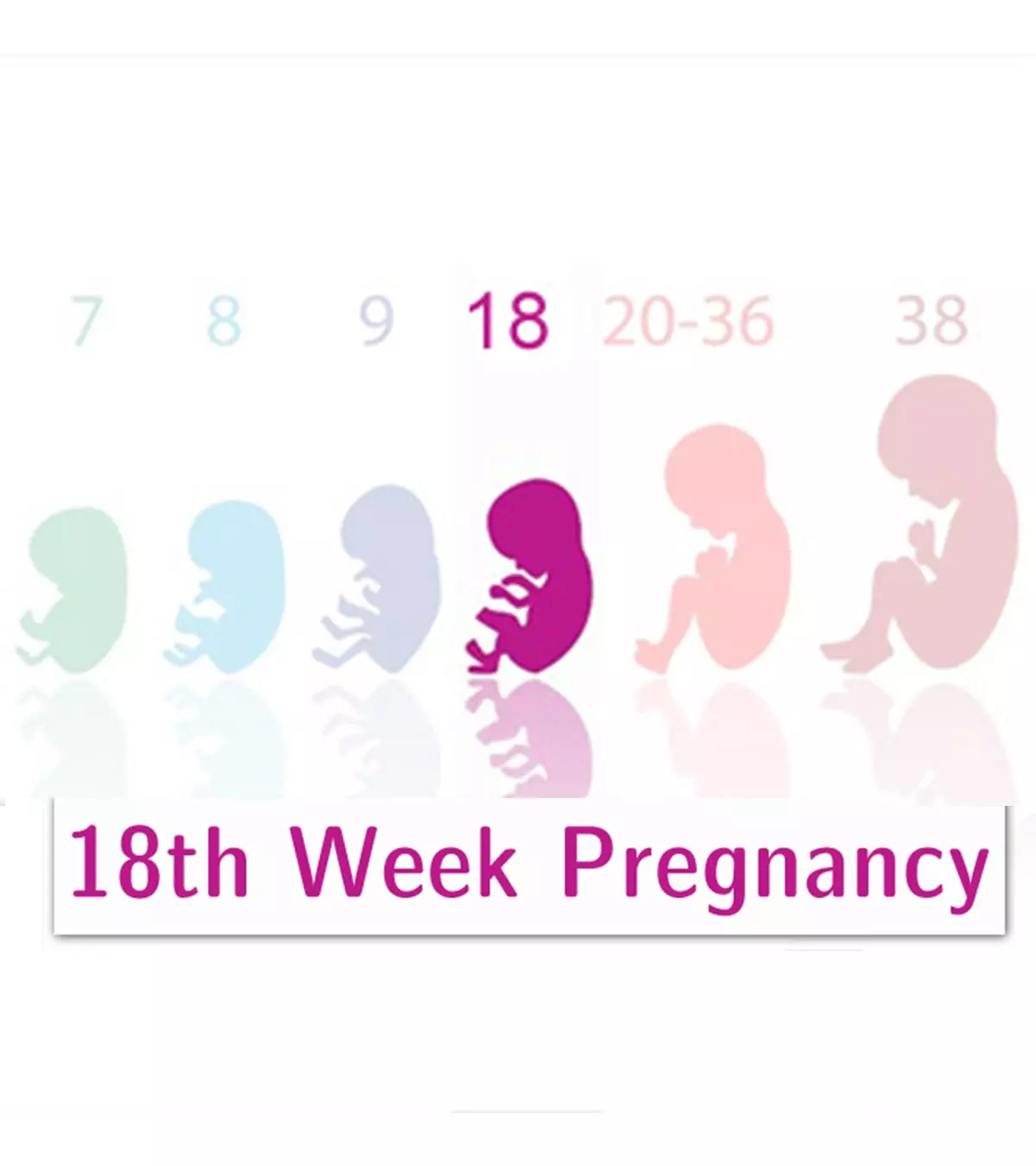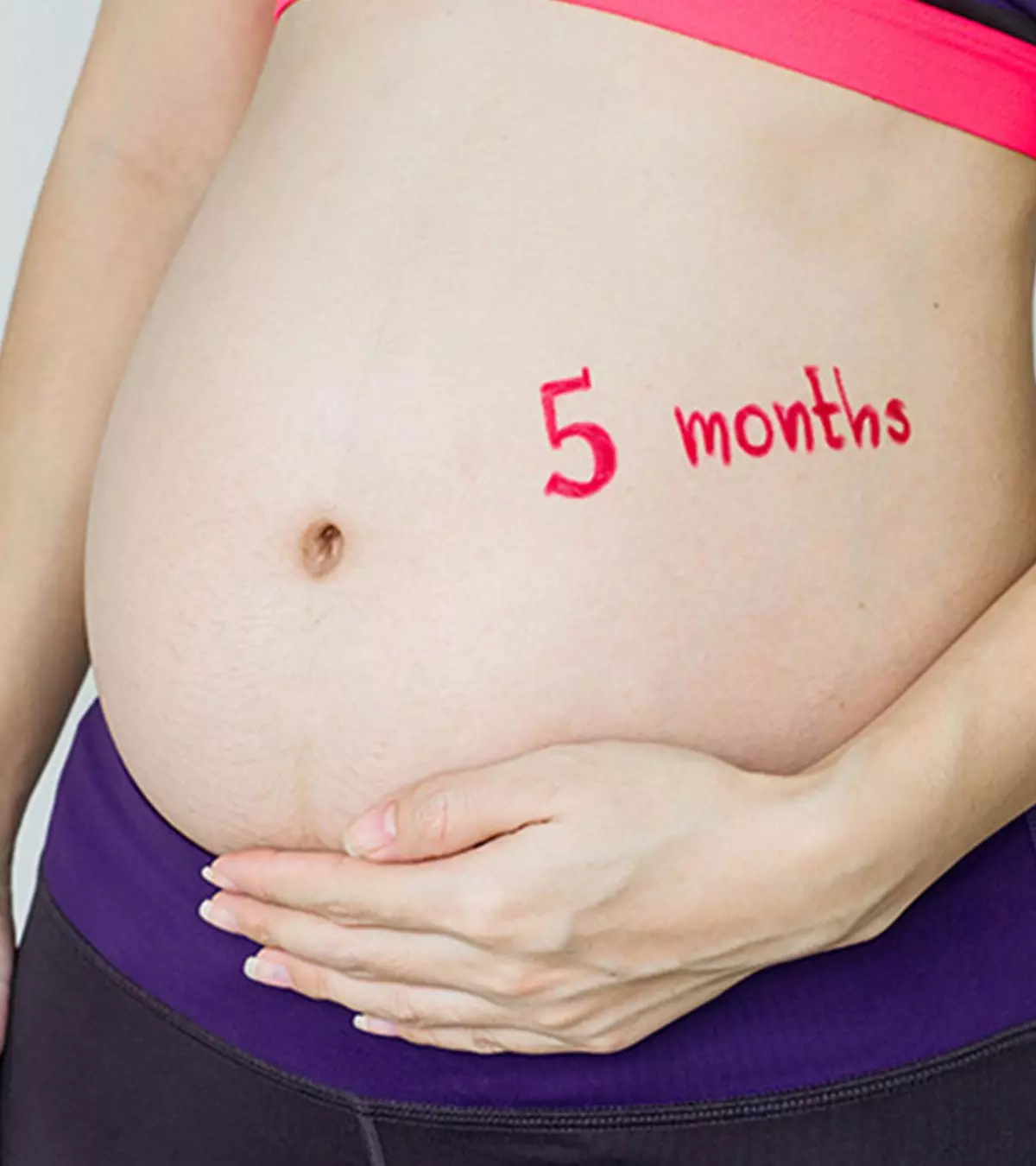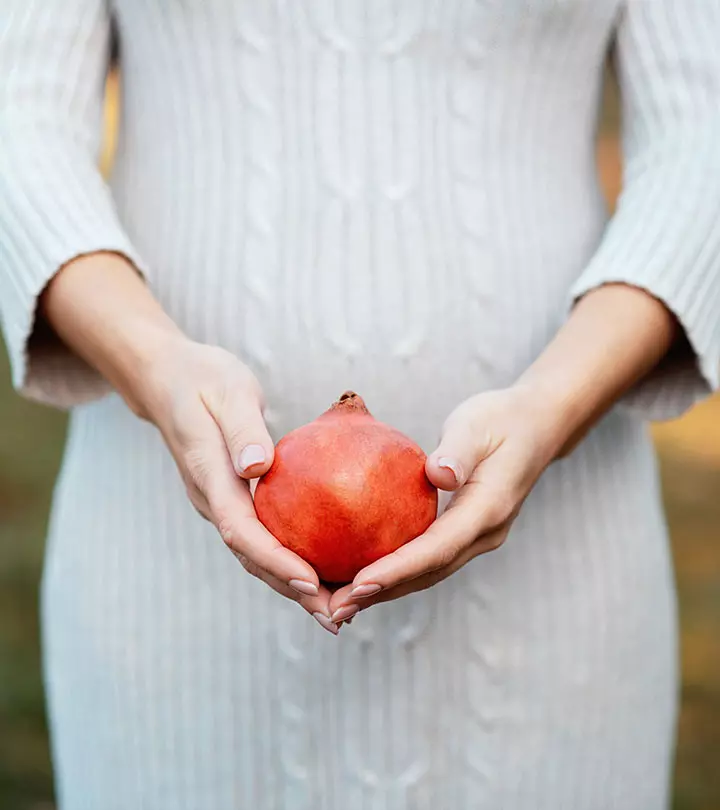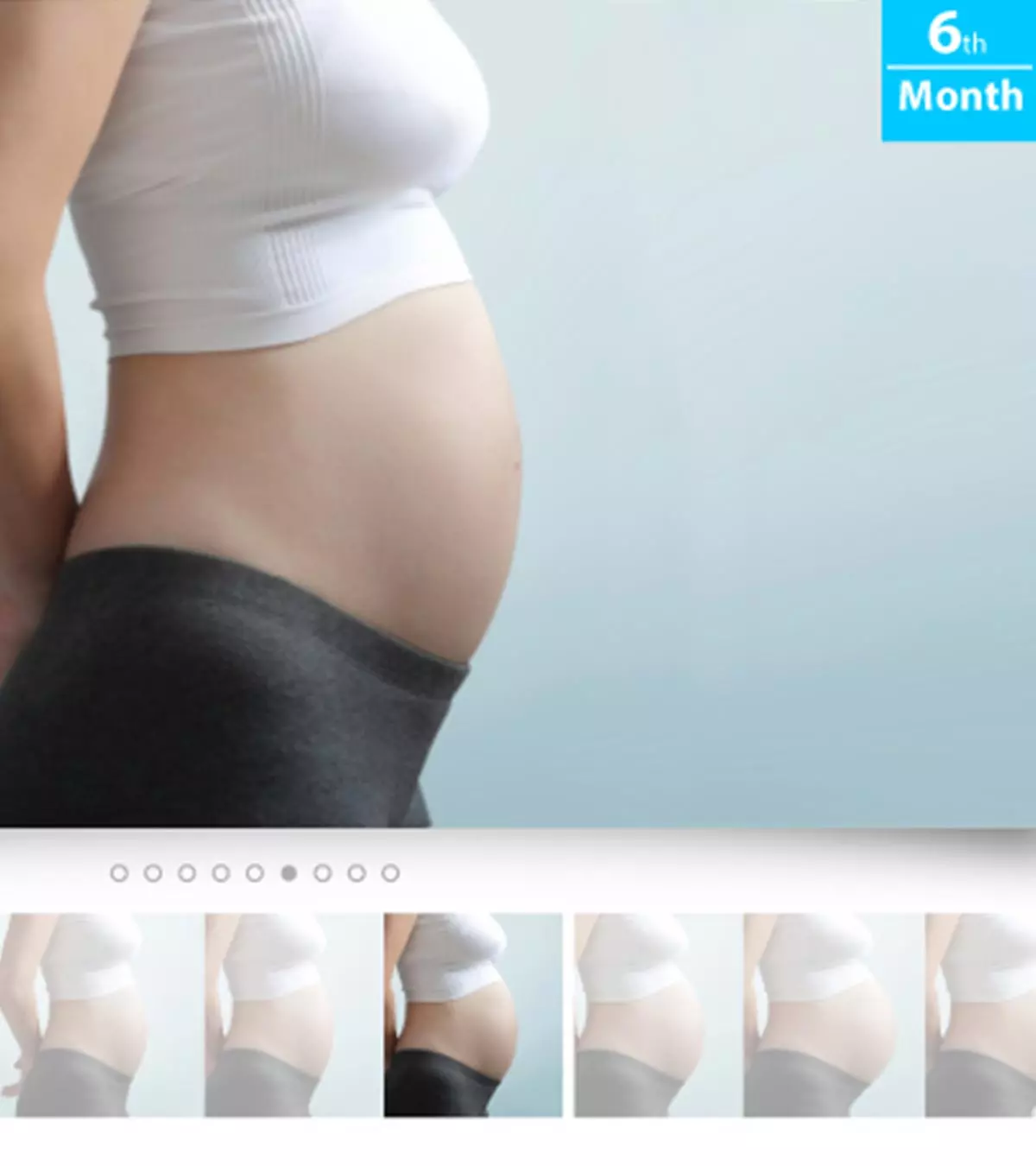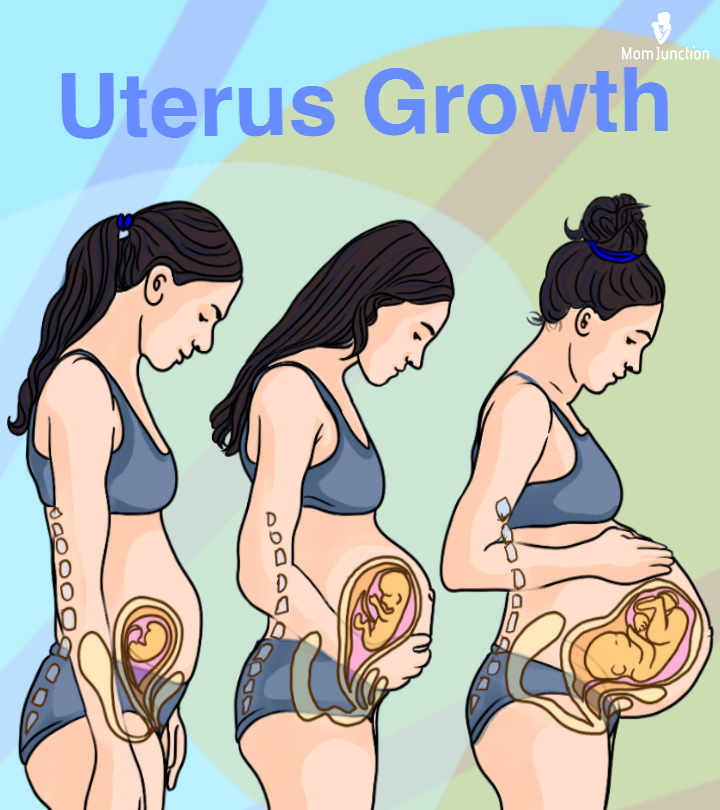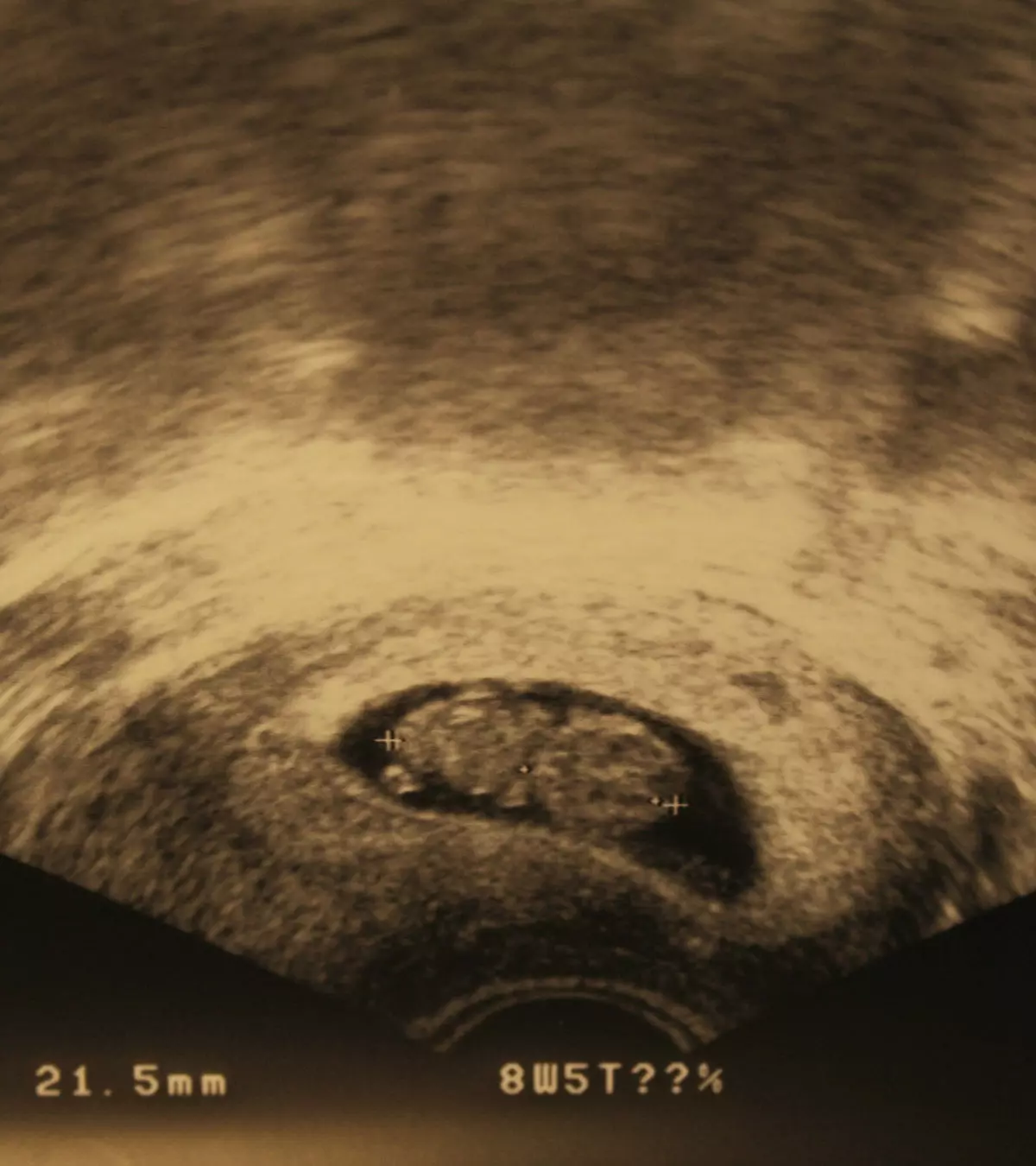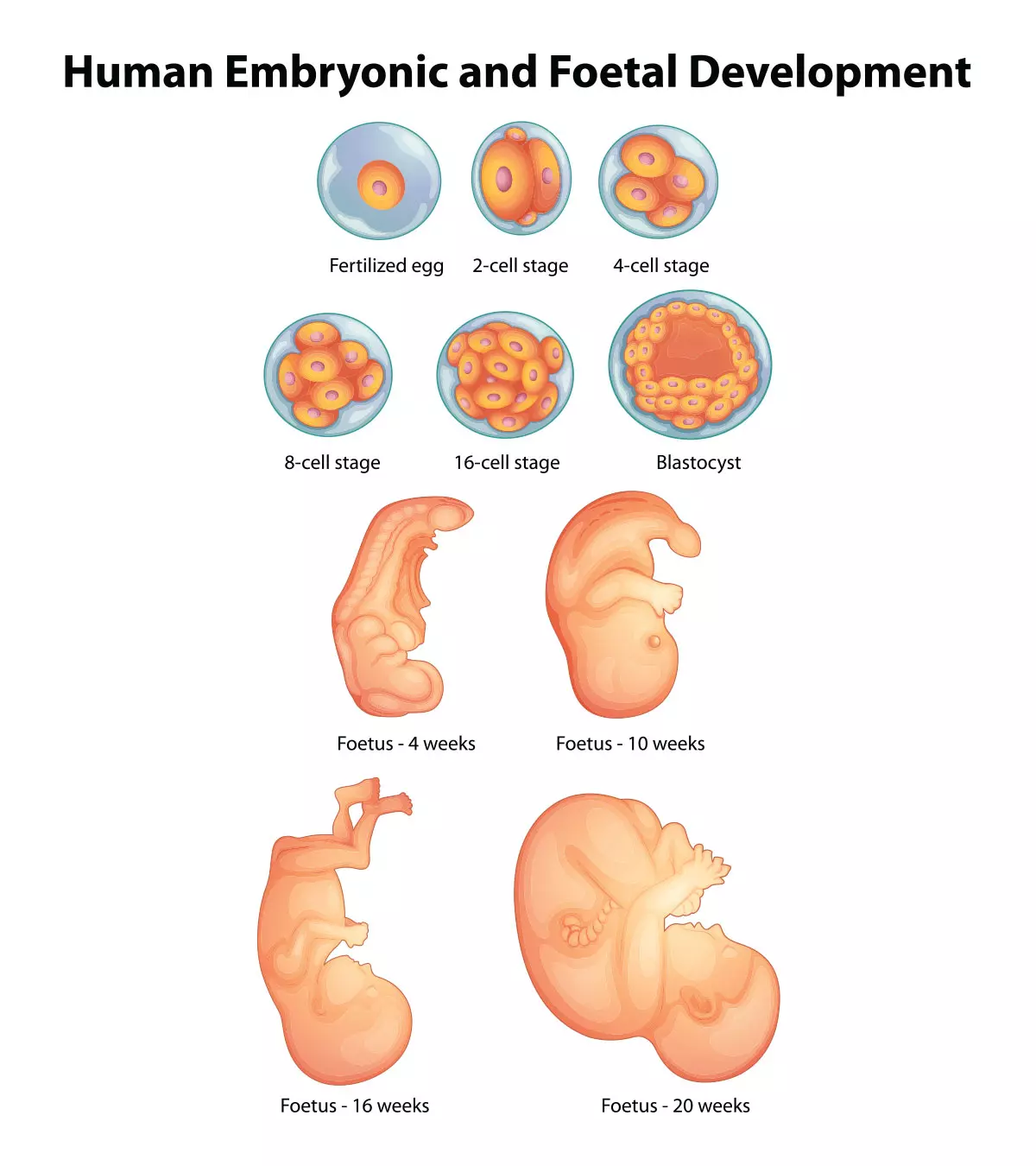
Image: Shutterstock
Frequent ultrasound images provide you with your baby’s glimpse now and then. However, you may be interested in learning more about your fetal development week by week. It can help you better understand your baby’s growth as the pregnancy progresses.

This post will explain how your baby develops inside your womb, including your baby’s size, every week’s development, and their senses and feelings inside your womb. We compare the size of the growing fetus to a fruit or vegetable, giving you better perspectives of the baby’s length and weight during each week of pregnancy (1) (2).
Key Pointers
- During Week 1, you may experience light bleeding, mild cramps, fatigue, nausea, vaginal discharge, and increased basal body temperature.
- During Weeks 4-7, the baby develops facial features, limbs, legs, and a spinal cord.
- During Weeks 11-17, the baby has learned how to breathe, swallow, and move its hands and legs.
- The mother may experience backache, Braxton Hicks contractions, edema, and abdominal pressure during Weeks 31-38.
- By Week 40, the baby has grown to the size of a small pumpkin and is ready to be delivered.
Week 1 to 3
Week one of gestation begins on the first day of your last period, followed by ovulation in the second week.
If the egg gets fertilized within 12 to 24 hours of ovulation, then the zygote (fertilized egg) travels through the fallopian tubeiA hollow tube-like structure in females connecting ovaries to the uterus during the third week. The zygote undergoes cell multiplication to form a blastocyst, which finally attaches to the endometriumiA layer of tissues lining the uterus where the egg implants after fertilization of the uterus, leading to conception.
Baby size: Not measurable
How you will feel: You may experience light bleeding, also known as implantation bleeding or spotting that is usually a pink or red discharge. Other symptoms include mild cramps, fatigue, nausea, vaginal discharge, and increased basal body temperature.
Week 4
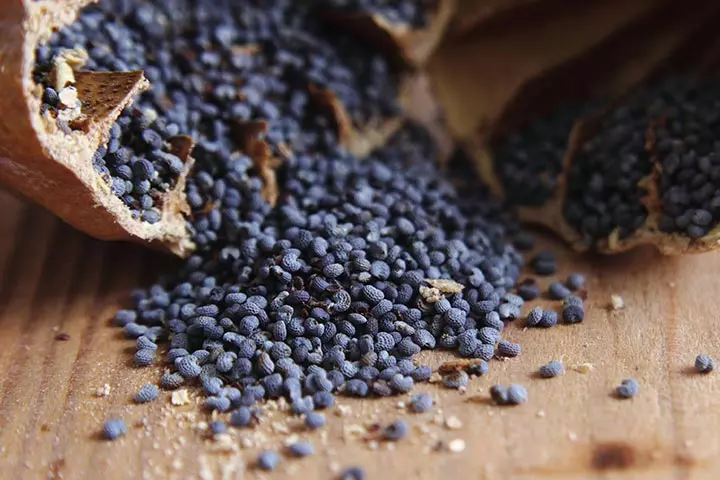
Baby size: It is about the size of a poppy seed.
Baby length: 0.1cm (0.04in)
Baby weight: Less than 1g (0.035oz)
Baby development:
- The placenta produces the human chorionic gonadotropin (hCG) hormone, which is essential for maintaining the uterine lining. Also, it alerts the ovary to halt the release of eggs to stop the monthly cycle for a few months (3).
- The embryo comprises three layers namely the ectoderm, mesodermiA middle layer of tissues in a developing embryo that develops into connective tissue, muscles cells, and crucial organ systems , and endodermiA inner layer of tissues in a developing embryo that develops into vital internal organs such as the digestive and respiratory systems . These layers develop into tissues and various organs of the body (4).
- Eyes and limb buds start to appear (5).
- Heartbeat and blood circulation start (6).
How you will feel:
You may experience bloating, mild cramps, breast tenderness, fatigue and nausea during this week.
 Quick fact
Quick factWeek 5
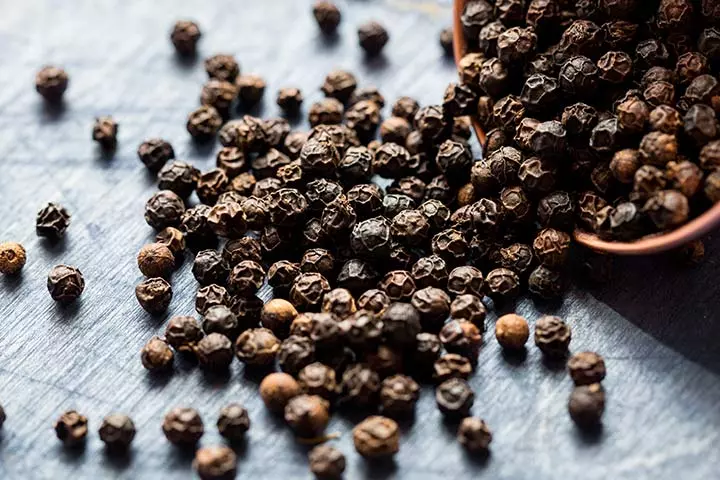
Baby size: It is about the size of a peppercorn
Baby length: 0.1cm (0.04in)
Baby weight: Less than 1g (0.035oz)
Baby development:
- The baby has a reptilian appearance (7).
- Neural development progresses, with the ectodermiAn outermost layer of tissues in a developing embryo that develops into the nervous system, skin, and other vital organs forming the neural tube, which further develops into the spinal cord and the brain.
- Development of the nervous system (8) and gastrointestinal tract begins (9).
- Leg buds and arms with webbed fingers begin to appear.
How you will feel:
Fatigue, lightheadedness, constipation, food cravings, frequent urination, tender breasts, and vaginal discharge during pregnancy are a few symptoms you may experience during this week.
.
Week 6

Baby size: It is about the size of a pomegranate seed.
Baby length: Around 1cm (0.4in)
Baby weight: Less than 1g (0.035oz)
Baby development:
- The baby’s hands and feet attain a paddle-like look (10).
- Ears take shape, the mouth begins to develop salivary glands and diaphragm is formed.
- Intestine and cerebral cortexiThe outer surface of the brain involved in wide range of neurological functions of the brain (11) begin to develop.
- Pancreas begins to produce glucagoniA pancreatic hormone that controls glucose levels in the blood .
- Adrenal cortex starts forming over the kidney.
How you will feel:
You may feel fatigued, be averse to foods, urinate frequently, experience a heightened sense of smell and mood swings during this week.
Week 7

Baby size: It is about the size of a blueberry
Baby length: Around 1cm (0.4in)
Baby weight: Less than 1g (0.035oz)
Baby development:
- Eyes, ears, mouth, and nose look distinct now (12).
- The umbilical cord is functional.
- The brain cells are being generated at a rate of 100/minute (13).
- The brain divides into forebrain, midbrain, and hindbrain.
- The skin is translucent and thin.
- Nephrons in the kidney begin to form. They are the basic filtration units of the kidneys (14).
- The digestion process begins with the development of the intestine.
- The liver starts producing the blood cells now.
- Pancreas begins the formation of insulin.
How you will feel: Morning sickness, fatigue, acne, food cravings, excessive saliva, and mild cramping are a few symptoms that you may experience during this week.
Week 8
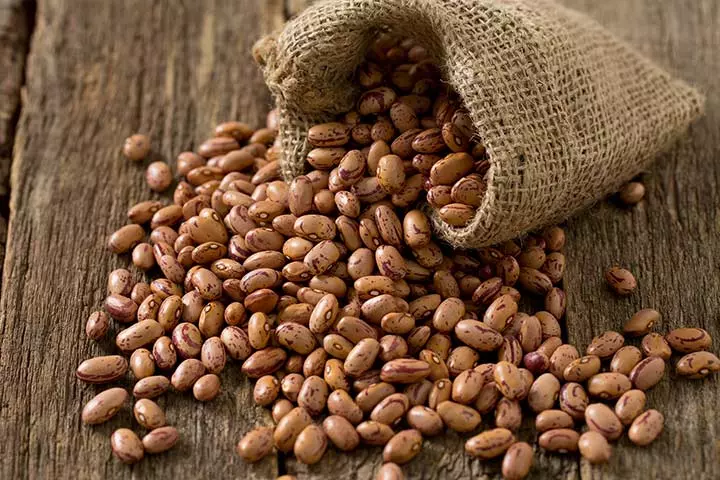
Baby size: It is about the size of a cranberry bean.
Baby length: 1.6cm (crown to rump) (0.62in)
Baby weight: Less than 1g (0.035oz)
Baby development:
- The size of the head is not in proportion with the body size (15).
- All the four chambers of the heart are developed by this week (16).
- The vertebral column of the spine is developed.
- The nervous system and the brain starts exchanging electrical signals.
- Blood is continuously pumped to the embryo through the umbilical cord.
- Retina starts developing, and the intestine gets longer in size (17).
How you will feel:
Some of the pregnancy symptoms during this week include bloating, constipation, fatigue, vaginal discharge, craving or aversion to food.
 Did you know?
Did you know?Week 9

Baby size: It is about the size of a cherry.
Baby length: 2.3cm (0.9in)
Baby weight: 2g (0.07oz)
Baby development:
- The baby has well-defined eyes and mouth.
- Taste buds are developed (18).
- Limb muscles are developing.
- Blood cells start forming in the liver.
- Arms and the elbows are still developing.
- The hair follicles and nipples begin to form.
- Skeleton begins to form.
- Body organs are developing.
- Skin is transparent, and blood vessels could be seen (19).
- Fingers and toes are growing (20).
How you will feel:
You may experience heartburn, bloating, fatigue, increased frequency of urination, tender breasts, constipation, and mood swings to list a few.
Week 10

Baby size: It is about the size of a kumquat.
Baby length: 3.1cm (1.22in)
Baby weight: 4g (0.14oz)
Baby development:
- The embryo is now called a fetus.
- The face has a human-like appearance.
- The head is in proportion to the body, making it half the size of the body.
- The skeletal structure is developing with the bones taking shape (21).
- Nails are growing on fingers and toes.
- Ears are taking shape and eyelids are forming.
How you will feel: Weight gain, pregnancy glow, acne, backache, and headache are a few symptoms to list for this week
.
Week 11

Baby size: It is about the size of a Brussels sprout.
Baby length: 4.1cm (1.61in)
Baby weight: 7g (0.25oz)
Baby development:
- Baby starts to open and close the fists (22).
- Brain and the nervous system are still developing.
- The heart starts pumping blood (23).
- Nails are growing.
- Teeth buds start developing in the mouth.
- The intestine starts functioning by absorbing water and glucose from the amniotic fluid swallowed by the baby (24).
- Genitals can be seen through an ultrasound scan.
How you will feel:
Nausea starts easing by this week and appetite increases. You may also experience other symptoms such as skin darkening, constipation, heartburn, and frequent urination.
Week 12

Baby size: It is about the size of a lime.
Baby length: 5.4cm (2.13in)
Baby weight: 14g (0.5oz)
Baby development:
- Fingers and toes remain webbed and are distinguishable.
- Major organ formation occurs, but they are not fully functional.
- Eyelids remain closed.
- Heartbeat is detected electronically.
- The kidneys now produce urine.
- By now the vocal cords are formed (25).
- The intestine ascends into the abdomen.
- Arms are proportional to the size of the body (26).
- Legs develop slower compared to the arms and may not be proportionate.
- The colon contains meconium, which is the first poop of the baby.
How you will feel:
You may experience fatigue, headache, dizziness, bleeding gums, gas and bloating during this week of pregnancy.
Week 13

Baby size: It is as long as a pea pod.
Baby length: 7.4cm (2.91in)
Baby weight: 23g (0.81oz)
Baby development:
- Eyelids remain closed to protect the eyes (27).
- Facial features like nose and lips are fully formed (28).
- Facial expressions are distinct by now.
- Bones are now connected by the ligaments. There are 27 bones in the baby’s hand (29).
- The webbed appearance of fingers and toes disappear.
- Unique fingerprints are developed.
- Breathing movements are being practiced (30).
- The placenta continues to produce the hormones progesterone and estrogen that maintain the pregnancy (31).
How you will feel:
You may have dizziness, gas or bloating, increased energy levels, vaginal discharge, mood swings, skin pigmentation, etc.
Week 14

Baby size: It is as big as a lemon.
Baby length: 7.4cm (2.91in)
Baby weight: 23g (0.81oz)
Baby development:
- Taste buds are present all over the mouth and tongue.
- Arms are long and thin and growing proportional to the size of the body.
- Fine hair called lanugo is forming on the body (32).
- Maturation of the thyroid gland occurs, and it starts secreting the thyroid hormone.
- Genitals are fully developed.
How you will feel:
You will start having the linea nigraiA dark (brown) colored line running vertically in the belly region during pregnancy , darker nipples and areola, blue veins, fuller hair, along with increased appetite, nasal congestion etc.
Week 15
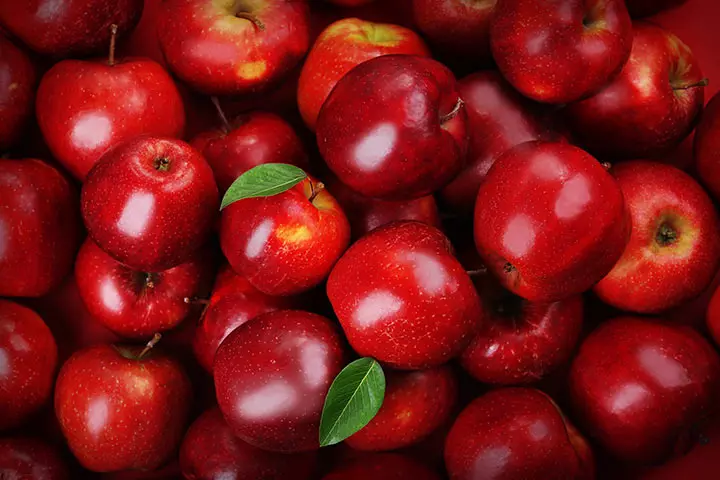
Baby size: It is as big as an apple.
Baby length: 10.1cm (3.98in)
Baby weight: 70g (2.47oz)
Baby development:
- Teeth buds in the mouth are developing.
- Skin is thin and transparent, making the blood vessels visible (33).
- They become sensitive to light.
- Muscles and the skeleton are developing.
- Fetal movements of hands, legs, feet, and the wrists begin.
- Begin movements like sucking, swallowing, and breathing.
How you will feel:
You may experience insomnia, dizziness, round ligament pain, constipation, memory lapses, etc. during this week.
Week 16

Baby size: It is as big as an avocado.
Baby length: 11.6cm (4.57in)
Baby weight: 100g (3.53oz)
Baby development:
- Sweat glands begin to develop.
- By now the baby can hold his/her neck erect (34).
- Facial muscles are developing and expressions like squinting and frowning can be seen on a scan.
- Legs are becoming longer.
- Genitals become distinguishable.
- Eyebrows and the eyelashes become distinct now.
How you will feel:
Pregnancy glow, backache, constipation, leg cramps, and heartburn continue this week. Besides these, you may feel the first kick of your baby, a feeling like you have butterflies in your tummy. It is called quickening or flutters.
Week 17

Baby size: It is about the size of a turnip.
Baby length: 13cm (5.11in)
Baby weight: 140g (4.93oz)
Baby development:
- Head is proportional to the size of the body (35).
- Fingernails and toenails grow till the tip.
- Wrinkled skin coated with vernix caseosaiWhite-colored, waxy layer covering the fetal skin in later stages of pregnancy (36).
- Bile that is necessary for the process of digestion begins to be secreted by the gallbladder.
- The blood cells begin to form in the bone marrow.
- Urine is passed by the kidney once every 50 minutes (37). It is the amniotic fluid swallowed by the baby.
- The umbilical cord is getting stronger and thicker.
- The eggs begin to form in the ovaries of a female fetus.
- The taste buds can now distinguish between bitter and sweet.
How you will feel:
Increased appetite, sciatic nerveiA long nerve running from the lower back to each leg through the hips pain, skin pigmentation, carpal tunnel syndrome, etc. are a few symptoms to list during this week.
Week 18

Baby size: It is about the size of a bell pepper.
Baby length: 14.2cm (5.59in)
Baby weight: 190g (6.70oz)
Baby development:
- Baby’s hearing ability is improving as the middle ear bone, along with the nerve endings, continues to develop (38).
- The bones in the clavicles and legs begin to harden.
- The eyes can now respond to the light.
- Bronchial tree formation inside the lungs is complete.
- Ears stick out from the head (39).
How you will feel:
Most of the symptoms from the previous weeks continue this week too. In addition to that, you may experience varicose veinsiDilated and enlarged veins, typically seen in the legs , insomnia, and edema.
Week 19

Baby size: It is about the size of an heirloom tomato.
Baby length: 15.3cm (6.02in)
Baby weight: 240g (8.47oz)
Baby development:
- Development of brown fat begins that keeps the baby warm (40).
- The skin has a coating called vernix and is covered with fine hair called lanugo.
- Ears are still developing, and the baby can hear the loud noises.
- The face looks more defined (41).
- Active movements can be felt.
- The ovaries of the female fetus consist of six million eggs (42), pg 158).
How you will feel:
The round ligament pain, dizziness, backache, edema, blurred vision, etc. continue in this week of pregnancy.
Week 20

Baby size: It is about the length of a small banana.
Baby length: 25.6cm (measured from head to heel) (10.08in)
Baby weight: 300g (10.58oz)
Baby development:
- The sebaceous glands in the skin start working.
- The baby’s movements can be felt.
- The sucking and grasping movements can be seen on an ultrasound scan.
- The lanugo starts disappearing (43).
- Permanent teeth are being formed inside the gums (44).
- The heart beats at the rate of 120-160 beats per minute.
- Myelin, a tissue coating starts covering the nerves (45).
How you will feel:
Vaginal discharge, shortness of breath, edema, food cravings are some symptoms that continue in this week.
Week 21

Baby size: It is as long as a carrot.
Baby length: 26.7cm (10.51in)
Baby weight: 360g (12.69oz)
Baby development:
- Body movements, the heartbeat, and breathing movement follow the circadian rhythmic pattern.
- The baby’s movements are felt stronger than earlier.
- The reflexes are almost developed.
- The liver and spleen support cell formation, and blood cells are formed inside the bone marrow (46).
- The digestive system is functional.
- The coating of vernix caseosa covers the skin.
- The brain is growing, and its surface remains smooth (47).
How you will feel:
Braxton Hicks contraction could be a concern during this week (48).
Week 22

Baby size: It is about the size of spaghetti squash.
Baby length: 27.8cm (10.94in)
Baby weight: 430g (15.17oz)
Baby development:
- The lower limbs are developed.
- Nails of fingers and toes are growing.
- Eyebrows and eyelashes are distinct.
- The intestine contains meconium.
- The baby’s kicks become stronger.
- Lanugo is present over the skin.
- Eyes begin to make rapid movements.
How you will feel:
Edema, constipation, heartburn, varicose veins, hemorrhoids, stretch marks, mood swings, urinary tract infection are a few issues you might have to deal with this week (49).
Week 23

Baby size: It is about the size of a large mango
Baby length: 28.9cm (11.38in)
Baby weight: 501g (1.1lb)
Baby development:
- Fat starts depositing under the skin.
- The lower airways in the lungs, also called alveoli, start developing.
- Skin remains wrinkled.
- Blood cells are still forming inside the bone marrow.
- Reflexes are developing, and the baby responds to light and noise.
How you will feel:
Edema, carpal tunnel syndrome, nasal congestion, Braxton Hicks contractionsiFalse contractions, usually experienced during the last stages of pregnancy are a few symptoms of this week.
Week 24

Baby size: It is as long as a ear of corn.
Baby length: 30cm (11.8in)
Baby weight: 600g (1.32lb)
Baby development:
- Skin is red and wrinkled.
- The fetus gains weight.
- Eyebrows and eyelashes can be seen clearly.
- The heart beats 30 million times by this week.
- The eyelids are distinctly separated but remain shut.
How you will feel:
Most of the symptoms persist and you might also experience blurred vision, itchy eyes, lower abdominal ache, stretch marks, colostrum leak from the breasts, and mood swings.
Week 25

Baby size: It is about the size of a rutabaga.
Baby length: 30cm (11.8in)
Baby weight: 600g (1.32lb)
Baby development:
- The baby’s rate of breathing is 44 times per minute around this week.
- The surfactant is created by the alveoli to maintain the surface tension in the lungs.
- The inner ear is fully developed by now.
- Fat deposition begins beneath the skin.
- A regular sleep and wake pattern develops by this week.
How you will feel:
Symphysis pubis dysfunction and restless leg syndrome (RLS) are common concerns during this week (50) (51). All the other symptoms continue.
Week 26

Baby size: It is about the size of a scallion.
Baby length: 35.6cm (14.01in)
Baby weight: 760g (1.68lb)
Baby development:
- Eyes are open and the baby can blink now (52).
- Head has more hair and the eyelashes are growing.
- Unique fingerprints and footprints are formed.
- Lungs are not completely mature.
- The baby’s reflexes and movements can cause an increase in the heart rate.
How you will feel:
You may experience clumsiness, memory loss, swelling, and round ligament pain, to name a few this week.
Week 27

Baby size: It is about the size of the head of cauliflower.
Baby length: 36.6cm (14.41in)
Baby weight: 875g (1.93lb)
Baby development:
- The liver, lungs, and the immune system are still developing (53).
- A coating of vernix caseosa covers the skin.
- The baby can recognize voices.
- The retina of eyes is almost developed, making the baby clearly distinguish between light and dark.
- The foot bones and the thigh bones measure about 2in (5cm) in length.
How you will feel:
Fast growing brittle nails, enlarged breasts with darker areola and nipple, and shinier thicker hair are a few physical changes you may notice this week.
Week 28

Baby size: It is about the size of a big eggplant.
Baby length: 37.6cm (14.80in)
Baby weight: 1kg (2.21lb)
Baby development:
- The brain grooves and folds are still developing (54).
- The fat that controls the body temperature of the baby continues to deposit under the skin.
- The nervous system starts controlling a few functions of the body.
- Eyes start producing tears and nose can smell.
How you will feel:
Leaky breasts, aches and pains, sciatic nerve pain, and stretch marks may continue to bother you during this week.
Week 29

Baby size: It is about the size of butternut squash.
Baby length: 38.6cm (15.19in)
Baby weight: 1.15kg (2.54lb)
Baby development:
- The baby is more active.
- The red blood cells are being formed in the bone marrow.
- The lungs start rhythmic breathing (55).
- Eyelids can open and close.
- Eyes respond to light.
How you will feel:
Hot flashes, headaches, shortness of breath, and heartburn continue to discomfort you.
Week 30

Baby size: It is about the size of a large cabbage.
Baby length: 39.9cm (15.71in)
Baby weight: 1.32kg (2.91lb)
Baby development:
- Fat deposition beneath the skin makes the baby look plump (56).
- Skin looks less wrinkled.
- The sleep pattern changes as the baby sleeps for longer now.
- The brain is still developing.
- Lungs are maturing.
How you will feel:
Heartburn, insomnia, fatigue, swelling, stretch marks, and darker linea nigra are a few that you’ll experience this week too.
Week 31

Baby size: It is about the size of a coconut.
Baby length: 41.1cm (16.18in)
Baby weight: 1.5kg (3.31lb)
Baby development:
- Baby starts urinating frequently (57).
- The intestine starts absorbing minerals like iron and calcium.
- In boys, the testicles descend into the scrotum.
- Around 40 million heartbeats occur by this week.
- Fat deposition continues making the skin appear less wrinkled.
- Bones are soft and fully developed
- Rhythmic breathing through lungs continues.
How you will feel:
Diarrhea, backache, clumsiness, Braxton Hicks contractions, colostrum leak, and anxiety are among the few symptoms that you may experience this week.
Julia, a mother, shares her experience of feeling the movements of her baby during the 31st week. She says, “I love it. She’s wild and the movements are definitely more rolls and vague jabs instead of jumpy little kicks. I’ve been worried that she won’t get head-down in there but this week I swear most of her movement is up under my ribs, so maybe her feet are finally settling in a bit (i).”
Week 32
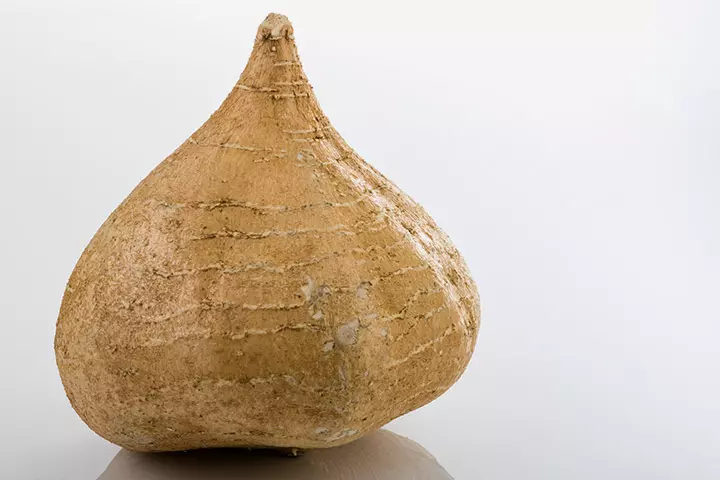
Baby size: It is about the size of a jicama
Baby length: 42.4cm (16.69in)
Baby weight: 1.7kg (3.75lb)
Baby development:
- The lanugo starts falling off (58).
- Lungs continue practicing rhythmic breathing.
- Kidneys are developed fully by now.
- Stronger kicks and movements can be felt.
- The baby sleeps for a long time.
- The baby attains a head-down position.
How you will feel:
Milky white discharge from the vagina, heart palpitations, itchy belly, and blue veins around the breast are a few symptoms you might experience this time.
Week 33

Baby size: It is about the size of a pineapple.
Baby length: 43.7cm (17.20in)
Baby weight: 1.9kg (4.23lb)
Baby development:
- The brain is still developing with a spurt in the formation of neurons (59).
- Eyes respond to light by contracting and dilating the pupil.
- Eyes start to move rapidly.
- Fat continues to accumulate under the skin.
- Lungs continue to develop.
How you will feel:
You may continue to experience back pain, edema, pregnancy brain, carpal tunnel syndrome this week too.
Week 34

Baby size: It is about the size of a cantaloupe melon.
Baby length: 45cm (17.71in)
Baby weight: 2.1kg (4.73lb)
Baby development:
- Lanugo disappears, but a thick coating of vernix is still there on the skin (60).
- The baby moves to the head-down position.
- Movements slow down due to insufficient space inside the womb.
- Stronger kicks are felt.
- The alveoli are still developing inside the lungs.
- Fingernails reach till the tip of the fingers.
- Skin looks smooth and pink in color.
How you will feel:
At 34 weeks pregnant, in addition to all other existing symptoms, you may experience abdominal pressure as well, due to the baby moving down toward the birth canal.
Week 35
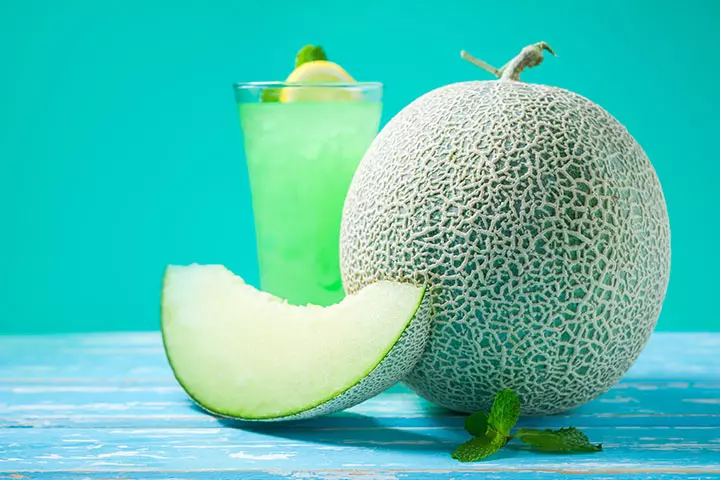
Baby size: It is about the size of a honeydew melon.
Baby length: 46.2cm (18.19in)
Baby weight: 2.3kg (5.25lb)
Baby development:
- Lanugo is gone, and a thick coating of vernix caseosa covers the skin.
- Surfactants are still being created in the lungs.
- The bones are soft, and the muscles are almost developed.
- Due to insufficient space, fewer movements are felt.
How you will feel:
You must be careful if you notice an unusual fluid leak through the vagina and contact the doctor. The other symptoms continue to be the same as experienced in the previous weeks.
Week 36

Baby size: It is about the size of romaine lettuce.
Baby length: 47.4cm (18.66in)
Baby weight: 2.6kg (5.78lb)
Baby development:
- The skull bones remain soft to allow easy passage through the birthing canal (61).
- Fully formed limbs with nails.
- Toned muscles that help the baby to move the neck.
- Earlobes have soft cartilage.
- The blood vessels are fully developed.
How you will feel:
You may experience abdominal pressure, hip pain, and Braxton Hicks contractions during this week.
Week 37

Baby size: It is as long as Swiss chard.
Baby length: 48.6cm (19.13in)
Baby weight: 2.9kg (6.30lb)
Baby development:
- The baby has a good grip of hand by now.
- The heart beats more than 50 million times by this week (62).
- A definite sleep pattern is developed.
- Movements are restricted.
How you will feel:
You may experience a bloody show, which is the discharge of blood streaks. It indicates that labor is imminent.
Week 38

Baby size: It is about the length of a leek.
Baby length: 49.8cm (19.61in)
Baby weight: 3kg (6.80lb)
Baby development:
- This week you attain full-term pregnancy.
- Fat deposition continues, and the baby’s growth halts at this point (63).
- Skin becomes smooth.
- Vernix and lanugo are shed.
- The head is larger compared to the body but is in proportion.
- The hair on the head is thick and coarse.
- Breast buds can be seen in both the sexes.
How you will feel:
Sleeping difficulty, back pain, edema, and bloody show are a few concerns of this week.
Week 39

Baby size: It is as big as a mini watermelon.
Baby length: 50.7cm (19.96in)
Baby weight: 3.3kg (7.25lb)
Baby development:
- The umbilical cord is about 20-24 inches in length.
- Vernix is fully shed.
- The placenta keeps supplying nutrients, antibodies, and oxygen to the fetus.
How you will feel: Lightning crotch
, pelvic pressure, bloody show, backaches continue to cause discomfort.
Week 40

Baby size: It is as big as a small pumpkin.
Baby length: 51.2cm (20.16in)
Baby weight: 3.4kg (7.63lb)
Baby development: The baby attains full growth by now and will be delivered any day from now.
Frequently Asked Questions
1. Which week of pregnancy is the most crucial for fetal development?
The first trimester of pregnancy (i.e., 0-12 weeks) is the most crucial time as all the significant fetal developmental changes (including the organs and the body structures) occur around this time. It also has the highest risk of pregnancy complications, including miscarriages and congenital abnormalities (64).
Dr. Laura Purdy, a US-based board-certified family medicine physician, says, “Each stage has its milestone. However, I think that the first few weeks of the first trimester are the most important. During this time, you are growing a placenta and a baby at the same time. It is crucial that the fetus develops all the organs properly. This is the time when the baby will be most susceptible to exposure. Certain medications are also not safe in the first trimester. Fetal alcohol syndrome and other substance exposures can have the greatest impact during this time.”
2. What is the first organ to form in a developing fetus?
The first organ to develop in a fetus is the heart and the circulatory system, which begins to form by four weeks of pregnancy (65).
3. When is fetal brain development most critical?
“It is the most critical in the first trimester because this is when all the structures are physically being created for the first time. The lobes of the brain and the vasculature, which includes the blood vessels, the spinal cord, and the nervous system, are developed in the early first trimester,” observes Dr. Purdy.
Knowing about your baby’s progress inside the uterus can be exciting. Even though your doctor suggests regular ultrasounds to know about the size and functions of your baby, keeping yourself informed with more details will help you connect better with your child. So, in this post, we have explained the fetal development week by week and provided a pictorial representation of the approximate size of the fetus as they keep growing. Looking at these pictures may help you understand how babies develop and what complex changes occur in them in 40 weeks. However, do not get too involved or worried about your baby’s growth. Always talk to your doctor if you have any concerns and enjoy a healthy pregnancy.
Infographic: Stages Of Fetal Development In The Last Trimester
As you reach your third trimester, you can see your bulging pregnancy belly and feel your baby. But what is happening inside? Let’s look at the infographic below to learn about your baby’s average size in a few key weeks of the third trimester. Illustration: Momjunction Design Team
Embark on a month-by-month journey through pregnancy with this all-encompassing video. Witness the gradual changes your body undergoes and prepare for the impending arrival of your bundle of joy with the aid of 3D animation.
Personal Experience: Source
MomJunction articles include first-hand experiences to provide you with better insights through real-life narratives. Here are the sources of personal accounts referenced in this article.
i. 31 weeks: Four oranges;https://julia-transition.blogspot.com/2012/03/
References
1. Week by Week Fetus Size Demonstrated by Fruits; EPAOA (2014-2019)
2. Fetal Development; UNSW Embryology (2018)
3. Week 4; The Nemours Foundation (1995-2019)
4. Your pregnancy and baby guide; NHS (2018)
5. Human Development – Weeks 4-8; SiH
6. Prenatal Form and Function – The Making of an Earth Suit; The Endowment For Human Development, Inc (2001-2019)
7. Pregnancy Week By Week; DueDateCalculator.org (2012 – 2019)
8. Pregnancy – 0 to 8 weeks; Healthdirect
9. Fetal development; NIH (2019)
10. Stages of Fetal Development – First Trimester; Louisiana Department of Health
11. Prenatal Form and Function – The Making of an Earth Suit; The Endowment For Human Development, INC (2001-2019)
12. Week 7; The Nemours Foundation (1995-2019)
13. Week 7 of pregnancy (Days 49-55); The Birth Company (2019)
14. Prenatal Form and Function – The Making of an Earth Suit; The Endowment For Human Development, INC (2001-2019)
15. Pregnancy – week by week; Department of Health & Human Services, State Government of Victoria, Australia (2018)
16. Fetal Growth And Development; South Dakota Department of Health
17. Week 8; The Nemours Foundation (1995-2019)
18. Your pregnancy week by week; NHS (2018)
19. 9 weeks pregnant; Raising Children Network (2006-2019)
20. You and your baby at 9 weeks pregnant; NHS
21. Fetal Growth And Development; South Dakota Department of Health.
22. Your baby’s growth and development – 3 months old; pregnancy, birth & baby
23. 11 weeks pregnant; Raising Children Network (Australia) Limited (2006-2019)
24. Prenatal Form and Function – The Making of an Earth Suit; The Endowment For Human Development, INC (2001-2019)
25. Week 12; The Nemours Foundation (1995-2019)
26. Prenatal Form and Function – The Making of an Earth Suit; The Endowment For Human Development, Inc (2001-2019)
27. Your pregnancy: weeks 13 to 16; Kaiser Foundation Health Plan, Inc (2018)
28. Prenatal Summary; The Endowment For Human Development, INC (2001-2019)
29. Baby Bump: Weeks 13-16; UnityPoint Health (2019)
30. First trimester: Your growing baby; Allina Health’s Patient Education Department (2015)
31. Week 13; The Nemours Foundation (1995-2019)
32. Week 14; The Nemours Foundation (1995-2019)
33. Week 15; The Nemours Foundation (1995-2019)
34. Week 16; The Nemours Foundation (1995-2019)
35. Pregnancy – 17 to 20 weeks; healthdirect
36. Prenatal Development: How Your Baby Grows During Pregnancy; American Congress of Obstetricians and Gynecologists (2017)
37. 17 weeks pregnant; Raising Children Network (Australia) Limited (2006-2019)
38. Week 18; The Nemours Foundation (1995-2019)
39. Stages of Fetal Development – Second Trimester; Louisiana Department of Health
40. Week 19: The Nemours Foundation (1995-2019)
41. The Pregnancy Book; Department of Health, UK (2010)
42. DK; Babycentre Pregnancy – from preconception to birth; Pg 158
43. Your pregnancy: weeks 17 to 20; Kaiser Foundation Health Plan, Inc (2018)
44. 20 weeks pregnant; Raising Children Network (Australia) Limited (2006-2019)
45. Tanaka S, Mito T, and Takashima S.; Progress of myelination in the human fetal brain; Early Human Development (1995)
46. Week 21; The Nemours Foundation (1995-2019)
47. 21 weeks pregnant; Raising Children Network (Australia) Limited (2006-2019)
48. Contractions During Pregnancy: What to Expect; HealthLink BC
49. KY Loh and N Sivalingam; Urinary Tract Infections In Pregnancy; Malays Fam Physician (2007)
50. Pelvic girdle pain and pregnancy; RCOG (2015)
51. R Gupta et al.; Restless legs syndrome and pregnancy; Acta Neurol Scand (2015)
52. Week 26; The Nemours Foundation (1995-2019)
53. Week 27; The Nemours Foundation (1995-2019)
54. Week 28; The Nemours Foundation (1995-2019)
55. Pregnancy Week By Week; DueDateCalculator.org (2012 – 2019)
56. Week 30; The Nemours Foundation (1995-2019)
57. Week 31; The Nemours Foundation (1995-2019)
58. Week 32; The Nemours Foundation (1995-2019)
59. Week 33; The Nemours Foundation (1995-2019)
60. Week 35; The Nemours Foundation (1995-2019)
61. Week 36; The Nemours Foundation (1995-2019)
62. Prenatal Summary; EHD
63. Week 38; The Nemours Foundation (1995-2019)
64. Pregnancy; UCSF Health
65. The First Trimester; Johns Hopkins Medicine
Community Experiences
Join the conversation and become a part of our nurturing community! Share your stories, experiences, and insights to connect with fellow parents.
Read full bio of Michael Fleischer
- Dr. Laura Purdy is a board-certified Family Medicine Physician with over a decade of experience. Previously a performing pianist, she later did her graduation in Psychology (Magna Cum Laude) from Ball State University and attended medical school at the Uniformed Services University of the Health Sciences. After graduating with a family medicine residency at Georgia’s Martin Army Hospital, she joined as a US Army physician.
 Dr. Laura Purdy is a board-certified Family Medicine Physician with over a decade of experience. Previously a performing pianist, she later did her graduation in Psychology (Magna Cum Laude) from Ball State University and attended medical school at the Uniformed Services University of the Health Sciences. After graduating with a family medicine residency at Georgia’s Martin Army Hospital, she joined as a US Army physician.
Dr. Laura Purdy is a board-certified Family Medicine Physician with over a decade of experience. Previously a performing pianist, she later did her graduation in Psychology (Magna Cum Laude) from Ball State University and attended medical school at the Uniformed Services University of the Health Sciences. After graduating with a family medicine residency at Georgia’s Martin Army Hospital, she joined as a US Army physician.
Read full bio of shreeja pillai
Read full bio of Rebecca Malachi
Read full bio of Aneesha Amonz





